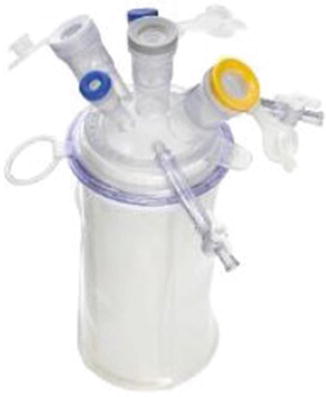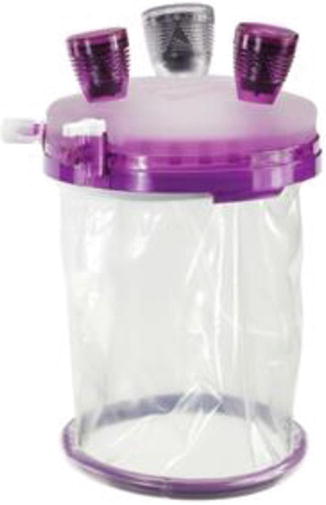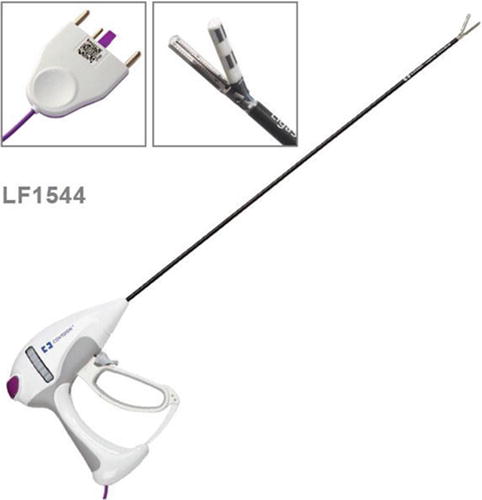Fig. 9.1
Covidien SILS Port
9.2.1.2 The QuadPort + (Olympus America; Center Valley, PA)
This port accommodates a 2–6-cm skin and fascial incision. The adjustable sleeve accommodates an abdominal wall up to 10 cm thick. In addition to the insufflation cannula, the port has five trocars: two 5 mm, one 10 mm, one 15 mm, and one 12 mm (Fig. 9.2). The configuration of the trocars cannot be changed, except that the larger trocars can be stepped down to 5 mm with an adapter.
The QuadPort + is notable for its adjustable wound sleeve and feature of five trocars. The limitation is that surgeons rarely utilize more than three trocars at any moment and the other two can get in the way. More importantly, the drag force that the trocars impart upon entry and withdrawal of instruments is much more than other trocar systems. The added force required to introduce, adjust, and withdraw instruments has the potential to contribute to surgeon fatigue. Furthermore, the added force required to make fine instrument adjustments has the potential to negatively impact the precision of these fine movements.


Fig. 9.2
Olympus QuadPort+
9.2.1.3 GelPOINT Advanced Access Platform
The platform is composed of an Alexis Wound Retractor (Applied Medical; Rancho Santa Margarita, CA) and a GelPort cover (Applied Medical; Rancho Santa Margarita, CA). It accommodates a skin and fascial incision between 1.5 and 7 cm. The adjustable wound retractor accommodates an abdominal wall up to 10 cm thick. The platform comes with four trocars: three 10 mm and one 15 mm (Fig. 9.3). The trocars can be oriented in the GelPort cover in any configuration. They can be removed and repositioned as needed given the GelPort’s self-healing capability.
Because the GelPOINT utilizes an Alexis Wound Retractor and a GelPort cover, it affords the surgeon the greatest degree of configuration flexibility among the single-site access platforms. The surgeon may utilize any of the four trocars in any desired configuration as he or she places the trocars into the GelPort according to the needs of the case. The trocars can be removed and replaced at any time. The self-healing property of the GelPort prevents gas leaks even after configuration changes. The incision can be extended to facilitate specimen removal. Single-site surgery can continue with the GelPOINT as long as the incision diameter does not exceed 7 cm. Portions of the procedure, such as an omentectomy, can be performed open using the Alexis Wound Retractor without the GelPort cover, followed by single-site pelvic laparoscopy (e.g., hysterectomy, bilateral salpingo-oophorectomy with lymphadenectomy).


Fig. 9.3
Applied Medical GelPOINT Advanced Access Platform
9.3 Dissectors
Successful completion of single-site gynecologic surgery requires a dissector capable of sealing and dividing vascular pedicles. Although many energy sources are available, the most applicable to gynecologic surgery are bipolar and ultrasonic dissectors. Ionized noble gas dissectors and laser dissectors, while useful in specific circumstances, are not sufficient by themselves in completing common gynecologic procedures such as hysterectomy.
9.3.1 Bipolar Dissectors
The most basic bipolar dissector uses a bipolar waveform supplied by a generator such as the ForceTriad (Covidien; Mansfield, MA) or an older ValleyLab electrosurgical generator (Covidien; Mansfield, MA) connected to a bipolar grasper such as the Sovereign Bipolar Maryland forcep (Aesculap, Inc.; Center Valley, PA). While effective, this configuration lacks the security afforded by dynamic tissue impedance detection. Thus, the surgeon has no objective measure of therapeutic effect and no objective means to determine treatment length. Undertreatment risks pedicle bleeding; overtreatment increases thermal spread and risk of occult injury to nearby tissues.
Several vendors provide bipolar dissectors that incorporate tissue impedance detection during the treatment cycle. Some systems automatically end treatment cycles once a threshold impedance is achieved, e.g., LigaSure (Covidien; Mansfield, MA; Fig. 9.4), while others provide dynamic audible cues regarding tissue impedance, allowing the surgeon to titrate the energy dosage to the desired impedance: Plasma Kinetic Dissecting Maryland Forceps, Fig. 9.5 (Gyrus Medical; Maple Grove, MN). The Caiman Dissector (Aesculap; Center Valley, PA; Fig. 9.6) combines impedance detection with pulse wave form modulation to achieve vessel sealing with less current and lower thermal spread. This dissector features an articulating jaw.










